Birch Water Market Research, 2031
The global birch water market size was valued at $1.2 billion in 2021, and is projected to reach $2.4 billion by 2031, growing at a CAGR of 7.2% from 2022 to 2031.
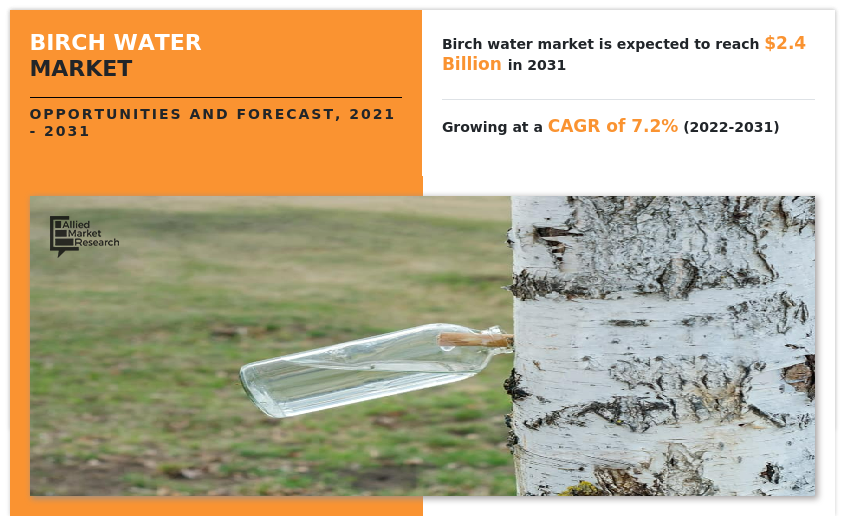
The birch water market is segmented into Nature, Distribution Channel, Type and Application.
Birch water is a liquid or fluid that is directly tapped from the various birch trees, which include Betula occidentalis (red birch), Betula pendula (silver birch), Betula alba (white birch), Betula lenta (black birch), and Betula papyrifera (paper/white birch). Birch water is also known as birch sap. It is a transparent and sweet liquid and has a silky texture.
Birch water is traditionally considered to be a “super drink” owing to the natural presence of vital nutrients such as manganese, zin, calcium, potassium, and magnesium. It has been used as a medicinal ingredient and health drink by the populous in Canada, Eastern Europe, and China over the past century. For centuries, birch water has been known for detoxifying the body by removing toxins. Birch sap is a pure natural detox elixir that is low in calories and sugar and high in minerals and vitamins. As per an article by birch-sap.org, birch sap is rich in minerals, trace elements, and vitamins, especially B vitamins. It remineralizes joints and strengthens and rehydrates muscles for athletes, convalescent, and elderly people. The birch water contains a component named saponin which absorbs cholesterol, due to which it is helpful in reducing the cholesterol level. Along with this, it also drains the liver and uric acid from the body due to its anti-inflammatory effect. A 300ml of birch water contains 95% of the daily value of magnesium and 130% of daily manganese and birch water can also aid in weight loss as it eliminates excess salt and cleanses the urinary tract of harmful toxins. Therefore, the rising awareness among consumers regarding the numerous health benefits of birch water is expected to boost the birch water market demand for direct consumption, during the forecast period.
There is a surge in the demand for organic products among the global population. Rising awareness regarding the benefits of organic products, a rise in disposable income, and rapid urbanization are some of the reasons behind such an increase in the demand for organic products. According to the National Library of Medicine of the U.S. government, suggestive evidence indicates that organic food consumption may reduce the risk of allergic disease and of overweight and obesity, but residual confounding is likely, as consumers of organic food tend to have healthier lifestyles overall. Consumers are preferring organic products due to all these benefits of organic products which will result in the increased demand for organic plant-based water. Increasing demand will drive market growth for birch water. Therefore, rise in inclination toward organic food and beverages products is expected to drive the global birch water market growth in the upcoming future.
Furthermore, the rising applications of birch water in the personal care and cosmetics industry is fueling the market growth significantly. Birch water usage is getting increased significantly due to its various advantages for the skin. According to an article by Femina, when applied regularly, birch sap is thought to reduce cellulite and ancillary marks. It also helps rejuvenate skin, tighten it, reduce acne, and serves as protection from UV rays and pollution. Due to its moisturizing and antioxidant qualities, which help with collagen synthesis and iron absorption, birch water has become a common element in lotions and other cosmetics. The vitamin C in birch water may also strengthen your hair. All these benefits will increase its usage in the cosmetic industry which will provide an opportunity for the birch water market to grow.
However, the high prices of birch water may restrain the growth of the market. According to an article by Femina, a 100 ml bottle of birch water costs Rs 1,500 or $18.8, which is very expensive for a consumer in a developing nation. Such a high price of it makes it difficult for the middle-class population to consume. Such a high price of the product puts weight on the pocket of a consumer due to which consumers generally avoid it which can hinder the growth of the birch water market in the region.
According to the birch water market analysis, the birch water market is segregated based on type, application, nature, distribution channel, and region. By type, the market is segmented into carbonated and non-carbonated. Both the carbonated and non-carbonated segments as further bifurcated based on flavor into strawberry, blueberry, raspberry, apple ginger, lemon, unflavored, and others. Based on the application, it is segmented into food and beverages, nutraceuticals, pharmaceuticals, and personal care and cosmetics. Further, on the basis of nature, the market is bifurcated into organic and conventional segments. Depending on the distribution channel, the market is categorized into direct distribution and retail distribution. The retail distribution is further segmented into modern trade, convenience stores, online stores, and others. Region-wise, the birch water market is analyzed across North America, Europe, Asia-Pacific, and LAMEA (Latin America, the Middle East, and Africa).
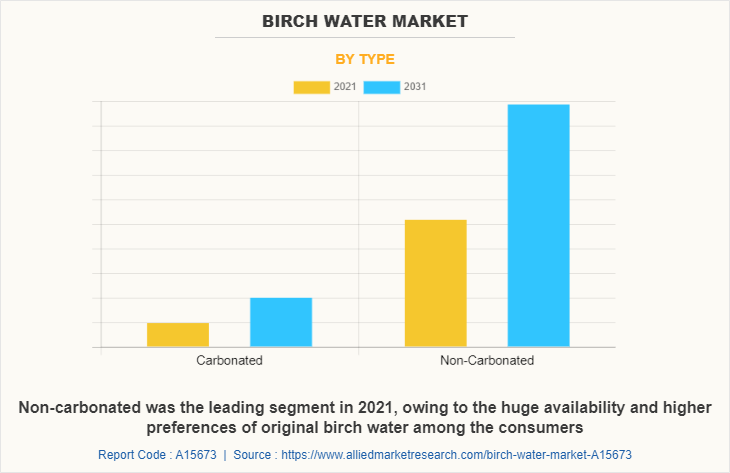
As per the birch water market forecast, based on the type, the non-carbonated segment dominated the market, accounting for 84.2% of the birch water market share in 2021. Carbonated drinks can cause bloating, burping, and other gas symptoms which is a major reason that majority of the consumers are opting for regular or non-carbonated birch sap. The availability of birch water in a variety of flavors such as watermelon, blueberry, raspberry, lemon, mint, mango, and apple ginger attracts a huge number of different customers. Furthermore, the high nutritional contents of birch water are creating an image as a super-drink among consumers. The rising awareness regarding the health benefits of birch water is expected to drive the growth of this segment during the forecast period.
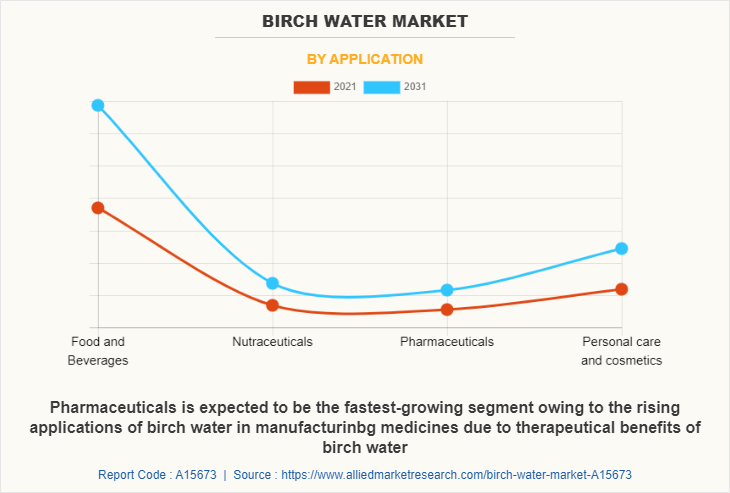
As per the birch water market trends, on the basis of application, the pharmaceuticals segment is expected to witness the highest CAGR of 8.0% during the forecast period. Birch water has certain properties that can be effective in the treatment of various diseases such as arthritis, gout, nephrolithiasis, and rheumatism. Moreover, birch water can reduce hair fall by strengthening hair and can clarify skin. Further, birch water is also effective in treating small kidney stones. These properties of birch water to effectively treat diseases are expected to drive the growth of this segment during the forecast period.
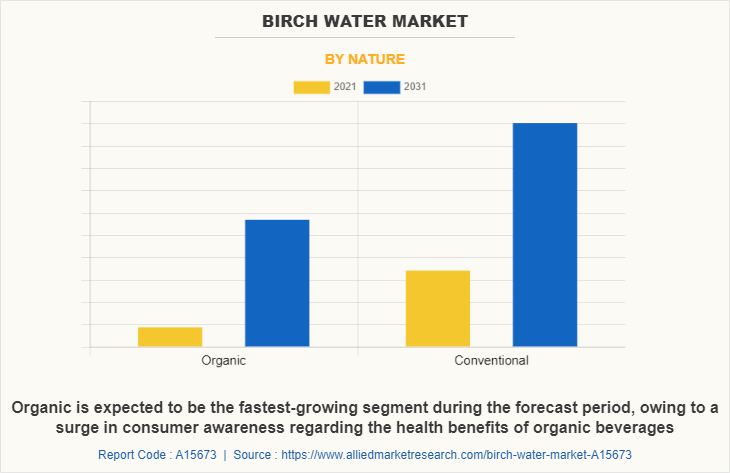
Depending on nature, the organic segment is expected to grow at the highest CAGR, during the forecast period, owing to the growing popularity and adoption of chemical-free and healthy food and beverages products. The growing demand for organic and natural products, as well as the health benefits of organic food and non-food products, are the two main factors driving the growth of the organic birch water market. According to Organic Trade Association in the year 2020-21, organic revenues exceeded $63 billion, with total annual growth of $1.4 billion. Food sales, which accounted for more than 90% of organic sales, reached $57.5 billion (approximately 2% growth) and non-food sales reached $6.0 billion (7% growth) in U.S. Additionally, the rising adoption of organic birch water in various industry verticals such as personal care, cosmetics, nutraceuticals, and food and beverages industries to manufacture organic products is expected to drive the growth of this segment during the forecast period.
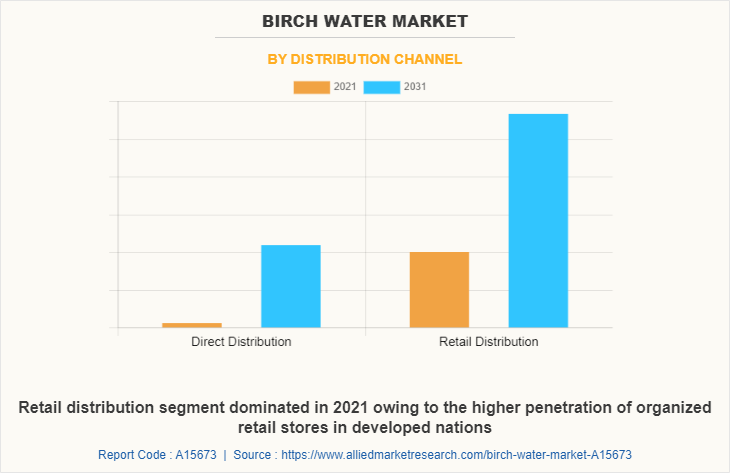
Based on the distribution channel, the retail distribution segment dominated the market accounting for 65.5% of the birch water market share in 2021. Retail distribution is gaining popularity, owing to the availability of a broad range of consumer goods and food and beverages under a single roof. In addition, the availability of ample parking space and convenient operation timings boost the sale of birch water through retail distribution channels. Moreover, the increase in urbanization, rise in working-class population, and competitive pricing drive the popularity of retail distribution in developed and developing economies has significantly contributed to the growth of the retail distribution channel. Furthermore, these retail stores offer a variety of brands in a particular product category, offering more options for consumers to buy the brands as per their choice. Thus, all these factors collectively contribute to the growth of the overall birch water market.
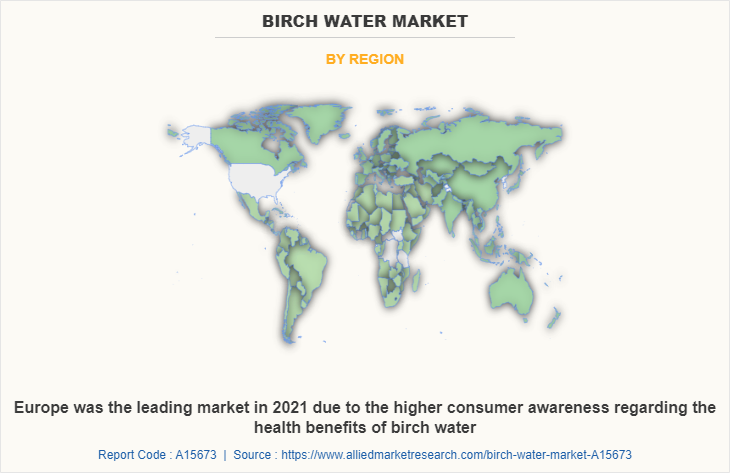
Region-wise, the market is analyzed across North America (the U.S., Canada, and Mexico), Europe (UK, Germany, France, Italy, Russia, Spain, rest of Europe), Asia-Pacific (China, Japan, India, South Korea, Australia, and rest of Asia-Pacific), and LAMEA (Brazil, Argentina, South Africa, Saudi Arabia, Colombia, Turkey, rest of LAMEA).
Europe was the dominant market with 39.8% of the revenue share in 2021, followed by North America with 33.3%. Europe comprises the UK, Germany, France, Italy, Russia, Spain, Rest of Europe. Europe has the major share of the birch water market and the consumption of birch water is increasing at a significant rate in Europe, owing to a rise in awareness of the health benefits of birch water. The availability of a huge number of birch trees is expected to emerge as another growth factor for the birch water market in Europe. The increasing popularity of healthy functional drinks, the desired decrease in sugar and energy intake, and new flavor launches are the leading drivers behind the growing interest in the birch water market in Europe. The main reason for market stagnation was strong competition from other plant-based water dinks. However, it is expected that consumption will increase in the coming years. In the Scandinavian countries, there is extensive use of birch water as an anti-aging cosmetic in the personal care and cosmetic industry.
Asia-Pacific is expected to be the fastest-growing market during the forecast period. The market will grow at the highest CAGR of 8.2% owing to its huge population and rise in disposable income. Alon with these factors, rapid urbanization of the region and rising awareness of the health benefit of birch water will also help the market to rise in the region. China is one of the countries in which birch water is used as a refreshing and healthy drink owing to its dominance in the region. Whereas India is expected to grow at the highest CAGR owing to rapid urbanization and a rise in disposable income.
Players operating in the birch water industry have used a variety of developmental strategies to expand their market share, exploit the birch water market opportunities, and boost their profitability. The key players operating in the birch water industry include The Birch Factory, Alaska Wild Harvest, LLC., Nordic Koivu Ltd, Vitalife Ltd, Eminence organic skin care, Procter & Gamble, Nature On Tap Ltd., Treo Brands LLC., Sublime life, JSC Straikas, Sibberi, and BelSeva.
Key Benefits For Stakeholders
- This report provides a quantitative analysis of the birch water market size, market segments, current trends, estimations, and dynamics of the birch water market analysis from 2021 to 2031 to identify the prevailing birch water market opportunities.
- Market research is offered along with information related to key drivers, restraints, and opportunities.
- Porter's five forces analysis highlights the potency of buyers and suppliers to enable stakeholders make profit-oriented business decisions and strengthen their supplier-buyer network.
- An in-depth analysis of the birch water market segmentation assists to determine the prevailing birch water market opportunity.
- Major countries in each region are mapped according to their revenue contribution to the global market.
- Market player positioning facilitates benchmarking and provides a clear understanding of the present position of the market players.
- The report includes an analysis of the regional as well as global birch water market trends, key players, market segments, application areas, and market growth strategies.
Birch Water Market Report Highlights
| Aspects | Details |
| Market Size By 2031 | USD 2.4 billion |
| Growth Rate | CAGR of 7.2% |
| Forecast period | 2021 - 2031 |
| Report Pages | 280 |
| By Nature |
|
| By Distribution Channel |
|
| By Type |
|
| By Application |
|
| By Region |
|
| Key Market Players | Alaska Wild Harvest LLC, Nature On Tap Ltd., Treo Brands LLC., The Birch Factory, Eminence Organic Skin Care Inc., Procter & Gamble, BelSeva, Sublime Life, Vitalife Ltd., Nordic Koivu Ltd. |
Analyst Review
Based on the insights of the CXOs, the global birch water market is expected to witness a strong growth in the near future owing to the rising preferences for vegan, non-GMO, preservative-free, gluten-free, and organic beverages among the health-conscious consumers. The growing demand for the functional and healthy food and beverages is a prominent driver of the birch water market. Moreover, the rising investments by the major players like Nature on Tap Ltd. and BelSeva on the introduction of tetra packaging to extend the shelf-life of the birch sap is expected to have a significant and positive impact on the growth of the birch water market in the foreseeable future. Furthermore, the rapidly growing popularity of the plant-based waters among the consumers is expected to fuel the demand for the birch sap owing to its nutritional and medicinal benefits.
The constant efforts by the various manufacturers in the pharmaceutical and cosmetics industry to introduce new and beneficial ingredients to manufacture innovative and organic products is fueling the demand for the birch water in nutraceuticals, pharmaceuticals, and personal care industries, globally. The ability of the birch water to treat hair loss, kidney stones, arthritis, and clarify skin is significantly boosting the demand for the birch water across various industry verticals.
The global birch water market size was valued at $1.2 billion in 2021, and is projected to reach $2.4 billion by 2031
The global Birch Water market is projected to grow at a compound annual growth rate of 7.2% from 2022 to 2031 $2.4 billion by 2031
The key players operating in the birch water industry include The Birch Factory, Alaska Wild Harvest, LLC., Nordic Koivu Ltd, Vitalife Ltd, Eminence organic skin care, Procter & Gamble, Nature On Tap Ltd., Treo Brands LLC., Sublime life, JSC Straikas, Sibberi, and BelSeva.
Asia-Pacific is expected to be the fastest-growing market during the forecast period
Rise in awareness among consumers regarding the numerous health benefits of birch water, Surge in the demand for organic products among the global population, Increase in awareness regarding the benefits of organic products, Rise in disposable income, Rise in applications of birch water in the personal care and cosmetics industry
Loading Table Of Content...



